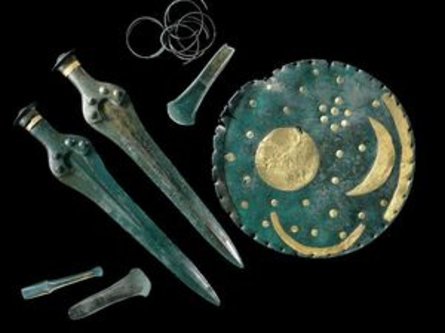
The Nebra Sky Disc (1,600 BC) is one of the most important archaeological finds of the last century. The bronze disc with gold appliqués displays the so far oldest concrete representation of the cosmos worldwide, making it a key find not only for archaeology, but also for astronomy and the history of religion. The Sky Disc was deposited 3,600 years ago together with two valuable swords, two axes, two arm spirals, and a chisel on the summit of the Mittelberg hill near Nebra. It is just one of many surviving hoards whose distribution in the Bronze Age spans the whole of Europe like a net.
The iconography of the Sky Disc shows the full moon or the sun, the crescent moon, and the Pleiades before a symbolic representation of the night sky. In later phases two horizon arcs, which reflect the sun’s annual course, as well as a solar barge were added. These representations conceal a wealth of information: the endpoints of the horizon arcs are aligned to the winter solstice and summer solstice, while the Pleiades, in combination with sun and full and crescent moon, signal the important dates for sowing and harvesting in the farming year.
The deposition of the Nebra Sky Disc coincides with the end of the Early Bronze Age era which was characterised by massive ostentatious tombs, trans-European trade relations, and social changes. One of the most important centres of this epoch was Middle Germany, which played a prominent role in prehistoric Europe due to its fertile soils and rich salt deposits.
For more information about the Nebra Sky Disc, visit www.himmelsscheibe.de.